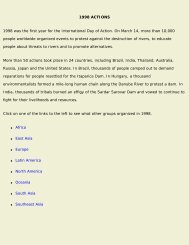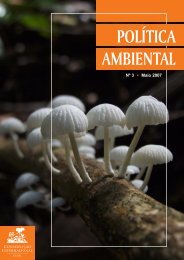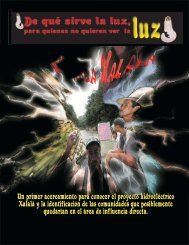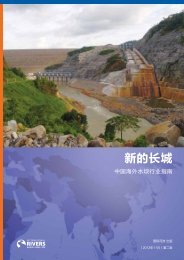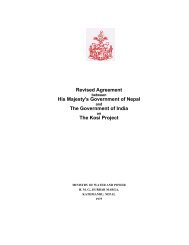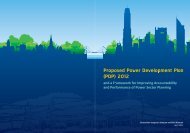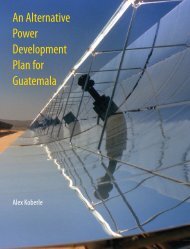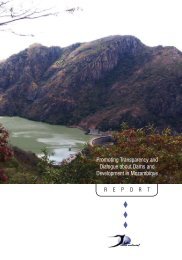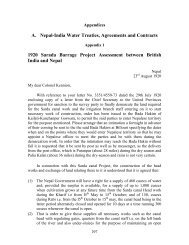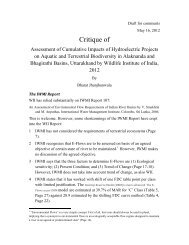Mountains of Concrete - International Rivers
Mountains of Concrete - International Rivers
Mountains of Concrete - International Rivers
Create successful ePaper yourself
Turn your PDF publications into a flip-book with our unique Google optimized e-Paper software.
References1 The term “greater Himalayan region” is used loosely to describe the areacovering all the high mountain chains <strong>of</strong> Central, South and Inner Asia, includingthe Tien Shan, Kun Lun, Pamir, Hindu Kush, Karakoram, Himalayas andHengduan. (Jianchu Xu, Arun Shrestha, Rameshananda Vaidya, Mats Eriksson,Kenneth Hewitt. 2007. The Melting Himalayas – Regional Challenges andLocal Impacts <strong>of</strong> Climate Change on Mountain Ecosystems and Livelihoods,ICIMOD Technical Paper. Kathmandu, ICIMOD.)2 http://en.wikipedia.org/wiki/Himalaya3 UNESCO. 2007. “Case Studies on Climate Change and World Heritage.”http://whc.unesco.org/documents/publi_climatechange.pdf. Accessed 3October 2008.4 Xu, J.C., Shrestha, A., Vaidya, R. Eriksson, M., and Hewitt, K. 2007. The MeltingHimalayas – Regional Challenges and Local Impacts <strong>of</strong> Climate Change onMountain Ecosystems and Livelihoods, ICIMOD Technical Paper, ICIMOD,Kathmandu.5 Several other major rivers <strong>of</strong> Asia like the Mekong, Yangtze, Yellow andSalween also emerge from the Himalayan region. However, as they originatein the Tibetan Plateau, which is geographically distinct from the Himalayas,sometimes they are not counted as ‘true’ Himalayan rivers. (http://en.wikipedia.org/wiki/Himalaya)6 There are also big plans for dam building in the Himalayan region in China/Tibet. Just one project planned on the Brahmaputra River at the Great Bend <strong>of</strong>Yarlung Tsangpo is likely to have almost as much installed capacity as the totalpotential <strong>of</strong> Nepal – 40,000 MW. However, our study has not looked at thedams in China for reasons outlined in the report.7 UNESCO. 2007. “Case Studies on Climate Change and World Heritage.”Accessed 3 October 2008. http://whc.unesco.org/documents/publi_climatechange.pdf8 A rim station project is a project built at the point where the river descendsfrom the hills onto the plains. This <strong>of</strong>fers the best possible location in terms <strong>of</strong>having good storage sites and yet being close to the plains where maximumscope exists for irrigated agriculture.9 The capacities are current capacities, extended from the initial capacities.10 Data for Nepal for 2006, India for April 2008, Bhutan for 2006, andPakistan for 2008. Source: Various Official Documents.11 A small part <strong>of</strong> the potential in Pakistan is also in the non-Himalayan regionbut is not mentioned separately.12 Capacity Already Developed for India includes capacity under construction.Total Potential for Nepal is estimated at 83,000 MW and out <strong>of</strong> this it isestimated that 44,000 MW can be economically developed. For Bhutan, totalpotential is estimated at 30,000 MW and 23,760 MW is the technically feasiblefigure. Source: Various Official documents.13 Nepal Electricity Authority (NEA). 2007. White Paper (in Nepali), page 13.Accessed 5 June 2008. http://www.nea.org.np/whitepaper.pdf14 Address <strong>of</strong> (then) President Musharaff to the nation, 17 January 2006, andWAPDA Future Projects. http://202.38.50.35/htmls/future-index.html15 http://www.wapda.gov.pk/vision2025/htmls_vision2025/hydropower.asp16 Actually, the capacities total 47,930 MW, an overwhelming 90% <strong>of</strong> which isin the Himalayas. http://www.nhpcindia.com/english/50000MW_initia-tive.htm17 Hydropower Policy 2008, Ministry <strong>of</strong> Power, Government <strong>of</strong> India, page15. Accessed 12 July 2008. http://powermin.nic.in/whats_new/pdf/new_hydro_policy.pdf. An overwhelming part <strong>of</strong> this capacity addition will bein the Himalayas.18 Willem van Gelder, J., Scheire, C. and Kroes, H. 2008. New Trends in theFinancing <strong>of</strong> Dams – A research paper prepared for <strong>International</strong> <strong>Rivers</strong>,BankTrack and WWF Germany (DRAFT). Castricum, Pr<strong>of</strong>undo.19 See later in this report, in the section Response <strong>of</strong> Civil Society andAffected People’s Groups for a differing opinion.20 Load-shedding means cutting <strong>of</strong>f electricity supply to specific users ona mostly predetermined schedule.21 Nepal Electricity Authority. 2007. Fiscal Year 2006/07 – A Year in Review.Annual Report <strong>of</strong> the NEA. Accessed 5 June 2008. http://www.nea.org.np/anrep7.pdf22 Ibid, page 6523 Based on figures given in Bhutan’s 10th Plan.24 Country Presentation on Bhutan at the BIMSTEC Workshop on Sharing <strong>of</strong>Experiences in Developing Hydro Projects,” 30-31 October 2006, New Delhi. ByTashi Dorjee Department <strong>of</strong> Energy, MTI & Kencho Dorji, Chukha HydropowerCorporation Ltd. Accessed 31 May 2008. http://powermin.nic.in/whats_new/pdf/Bhutan.pps.25 Ministry <strong>of</strong> Power, Government <strong>of</strong> India. Monthly GenerationReport, March 2008 http://cea.nic.in/god/opm/Monthly_Generation_Report/18col_T_08_03/FILE-1.pdf26 “Hydropower Changing Bhutan’s Economy.” Presentation by SonamTshering, Department <strong>of</strong> Energy, during the conference Emerging InvestmentOpportunities in South Asian Power Sector,” New Delhi. 21 March 2007.Accessed 11 July 2008. http://www.ficci.com/media-room/speechespresentations/2007/march/PPT/session5/DashoSonem.pdf27 Country Presentation on Bhutan at the BIMSTEC Workshop on Sharing<strong>of</strong> Experiences in Developing Hydro Projects,” 30-31 October 2006, NewDelhi. By Tashi Dorjee Department <strong>of</strong> Energy, MTI & Kencho Dorji, ChukhaHydropower Corporation Ltd. Accessed 31 May 2008. http://powermin.nic.in/whats_new/pdf/Bhutan.pps.28 Hydro Policy Out, new on Kuenselonline, 28 June 2008. http://kuen-selonline.com/modules.php?name=News&file=article&sid=1065529 General Facts – Country Pr<strong>of</strong>ile. Parliamentary Committee on WaterResources, Pakistan. http://www.pakwaters.gov.pk/gfacts.htm30 Pakistan’s Water Economy. World Bank. http://go.worldbank.org/WCKW2A5ZA031 Address to the Nation on 17 January 2006. Accessed 5 June 2008.http://president<strong>of</strong>pakistan.gov.pk/FilesSpeeches%5CAddresses%5C118200665651PMPresident%20address.pdf32 World Bank. 2005. Pakistan: Country Water Resources AssistanceStrategy, Water Economy: Running Dry November 14, 2005 Report No.34081-PK. South Asia Region, Agriculture and Rural Development Unit,South Asia Region, World Bank.33 Accessed 4 June 2008. http://www.president<strong>of</strong>pakistan.gov.pk/bhasha%20dam.aspx34 Presentation on Power Sector Development in Pakistan by Aftab AhmadKhan, Sherpao, Minister For Water And Power, Pakistan Development Forum,18 March 2004. Accessed 31 May 2008. http://siteresources.worldbank.org/PAKISTANEXTN/Resources/ Pakistan-Development-Forum-2004/PSD.pdf35 World Bank. 2008. Project appraisal document On a Proposed loanand Credit To the Islamic republic <strong>of</strong> Pakistan For an Electricity distributionand transmission improvement project In support <strong>of</strong> the first phase <strong>of</strong> Theelectricity distribution and transmission improvement program, May 22, 2008.Report No: 41328-PK. http://www-wds.worldbank.org/external/default/WDSContentServer/WDSP/IB/2008/06/12/000333038_20080612234849/Rendered/PDF/413280PAD0REVI10104301OFF0USE0ONLY1.pdf36 Power Scenario at A Glance, May 2008. Planning Wing, IntegratedResource Planning Division, Central Electricity Authority, Government <strong>of</strong> India.37 Government <strong>of</strong> India. 2007. Report <strong>of</strong> the Working Group on Power forthe Eleventh Plan (2007-12) Volume II, Main Report. Ministry <strong>of</strong> Power,Government <strong>of</strong> India, page 19 <strong>of</strong> chapter 3. Accessed 12 February 2008.http://planningcommission.nic.in/aboutus/committee/ wrkgrp11/wg11_power.pdf.38 Census <strong>of</strong> India 2001. Accessed 10 June 2008. http://www.censusindia.gov.in/Tables_Published/H-Series/H-Series_link/S00-019.pdf39 Ministry <strong>of</strong> Power. 2005. National Electricity Policy. Ministry <strong>of</strong> Power,Government <strong>of</strong> India. Accessed 26 June 2008. http://powermin.nic.in/JSP_SERVLETS/internal.jspM o u n ta i n s o f C o n c r e t e : D a m B u i l d i n g i n t h e H i m a l aya s | 4 1




